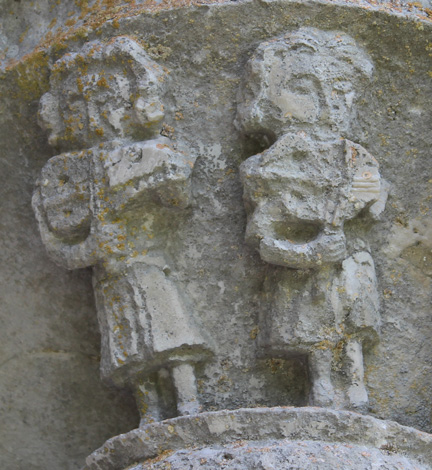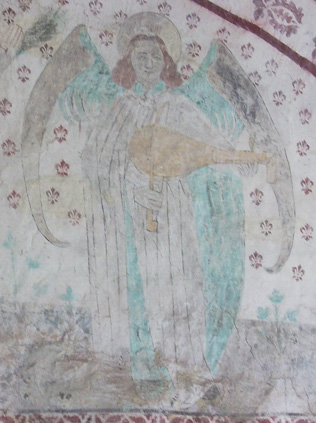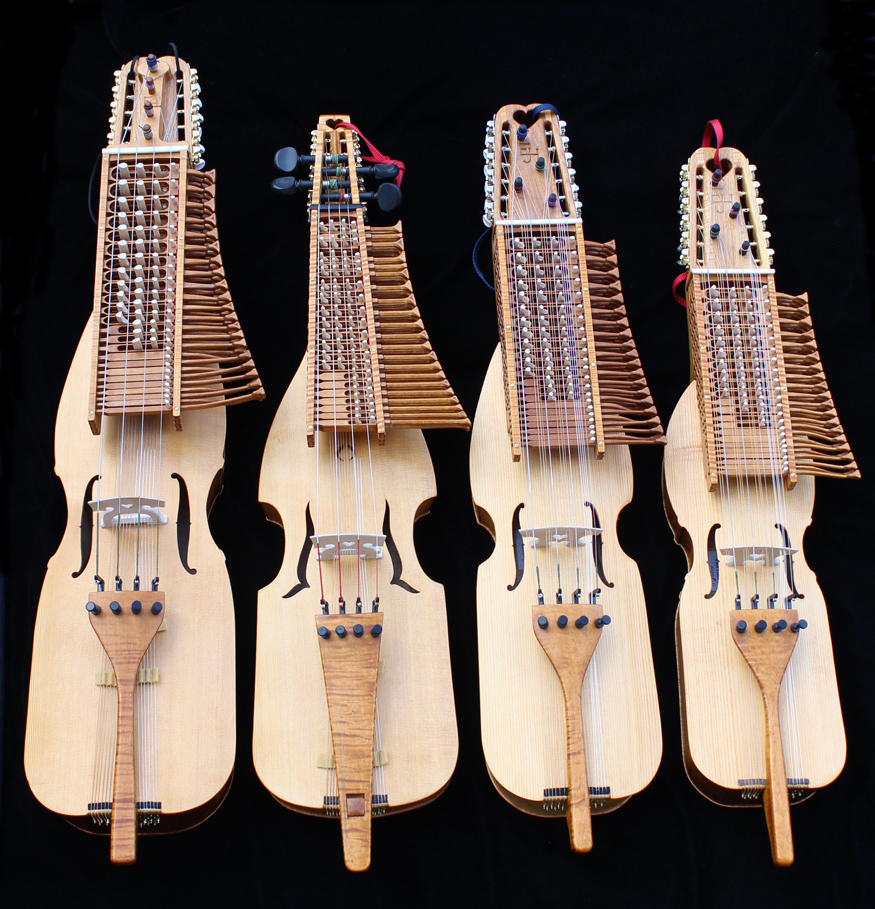Nyckelharpa History

There is a church stone carving (left) on the Källunge church on Gotland, Sweden of what appears to be an early nyckelharpa from about 1350 AD. There is a fresco in Italy from 1408 with a nyckelharpa image. There are old church paintings from the 15th and 16th centuries that show what appears to be nyckelharpa-type instruments being played by angels. These paintings exist in Denmark, Sweden and Italy, but it has not been possible to determine where these instruments were actually played at this time. There are no historic instruments from this time period. The painting below is from the Ősterlövsta church in Uppland from around 1468.
The nyckelharpa has been continuously played in the Uppsala region of Sweden since the mid-1600s.
There is an early version instrument from the 1680s, called a Moraharpa. There are a total of two instruments of this kind, both were found in the Älvdalen Parish, near Mora. These appear to be made based on a published drawing from 1620 by Pretorius. One is housed in the Zornmuseum in Mora, Sweden; thus the name. There is some debate about if they were even playable instruments.
There is another early nyckelharpa dated from around 1600 that was found in Esse Finland, and a similar one found in Vefsn, Norway.

There are modern reproductions of both the Moraharpa and Esseharpa being made.
The first well documented instrument type is called a kontrabasharpa and appeared in the Uppsala region of Sweden between 1630 and 1640. This instrument was played up though the 1930's. This was a commoner's instrument and used for listening music and dancing. It was probably mostly played solo. This instrument could play in the keys of C, G and D. Due to length and tension issues, the gut strings could not be tuned to an E, so the highest string was tuned to an A. The highest melody string was of twisted silk and the highest drone of an overspun silk string.
In the 1860s, the nyckelharpa got an extra row of keys for chords like the then new accordions, and used silver-wound strings, which had recently come into production. The term silverbassharpa for this version was coined by a journalist in 1899 but only came into modern use after 1967. The silverbasharpa could only play in the key of C.
In 1929, August Bohlin did some re-design and built the first 3-rowed fully chromatic nyckelharpa. This design was slightly revised by Eric Sahlström and is now considered the basis for the common 3-rowed chromatic nyckelharpa. Due to the large body of music available for this instrument, there was no perceived need for an E string to be added.
The nyckelharpa almost died out in the late 1950's, but was brought back through an intentional effort by the Swedish government. This tied in with the folk revival of the late 1970's.
The terms: Kontrabasharpa and Silverbasharpa are modern terms for the older versions of the nyckelharpa. There are also other early versions with names that often come from the location the instrument was found.
Per-Ulf Ullmo has published a comprehensive history of the Nyckelharpa, but it is currently only in Swedish. Per-Ulf provided editing/input to this brief history of the nyckelharpa.
The nyckelharpa is not what can be called a mature instrument. It is still evolving and developing.
There is additional information available about the history from the CADENCE and American Nyckelharpa Association web sites.
More Recent Nyckelharpa Developments:
This leads us to what is the current nyckelharpa situation. The following discussion is mostly based on Earl’s observations of the nyckelharpa state of affairs in Sweden, Germany and France from visits over several years, along with interactions among members of the nyckelharpa community.
The nyckelharpa has been continuously played in Sweden since the early 1600s. It almost died out in the mid-1900s, but in the late 1950s, the Swedish government decided to revive the nyckelharpa. They had Erik Salhstrom update a nyckelharpa plan and use this plan in a series of workshops to teach people how to build and then play the nyckelharpa. The plan that was developed was for the 1929 model 3-rowed chromatic instrument. So, what Erik revived was the most current/modern version of the nyckelharpa at that time.
These workshops were offered so that anyone who wanted a nyckelharpa could build one. Most of the people who took these workshops were average people who had little or no wood working experience or Luthier training. Some of the people who took these workshops then built more instruments and this led to the development of a cottage industry of what are basically amateur luthiers who can build 3-rowed nyckelharpas. Some builders then expanded to make copies of the Mora harpa, Kontrabass and Silverbass nyckelharpas.
At the same time, the Swedish nyckelharpa music took off during the folk revival period of the 1960s and 70s. Many of the older players of today learned the old tunes from the 12 players who kept the tradition alive to be revived. These older players are very proud of this preserved heritage and want it to be preserved as they learned it. But like any tradition, it lives, it grows and it evolves. So, what we really have is a mid to late 20th century modern living Swedish folk tradition.
Today in Sweden, there is a well-developed cottage industry of mostly armature luthiers who can make very good 3-rowed chromatic nyckelharpas, as well as Mora harpas, Kontrabass and Silverbass nyckelharpas. Many of these nyckelharpas are exported.
Most of the builders in Sweden are retired men who are building as a part-time hobby. I suspect that most of them are not actually officially in business. Several of these builders have priced their instruments so that a young Swede who wants to play, can afford a good nyckelharpa. This results in two conditions in Sweden; first the price for nyckelharpas is low. This is very good for musicians. Second, the professional Luthiers who need to track time, materials and other costs can’t really afford to build nyckelharpas, so most of them don’t. These are the builders who would be best able to develop 4-rowed nyckelharpas in Sweden, if they could afford to build them. Sweden is a great place to buy low cost 3-rowed nyckelharpas.
The plans that have developed for the 3-rowed chromatic nyckelharpa are well done, easy to follow, and result in a good sounding nyckelharpa body that works very well with 3 rows of keys. However, if you try to add a 4th row of keys to this body, the additional row of keys generally does not have good sound. Earl knows that Swedish builders have been trying to add a 4th row of keys since at least 1970. The standard 3-rowed nyckelharpa body needs to be modified to work with a 4th row of keys. As of March 2019, Earl was told by a high-level Swedish player that no one in Sweden was making good 4-rowed nyckelharpas.
In about 2000, Johan Hedin led a design project that resulted in a 4-rowed tenor nyckelharpa with some ¼-tone notes. We understand there were a number of nyckelharpa builders as well as a violin maker and a guitar builder involved. Building this instrument requires advanced wood-working skills. The range is one octave below a violin (1/5th above a cello), and the sound works well for baroque style music. Most of the current Swedish nyckelharpa builders lack the luthier/wood-working skills to make this version of the nyckelharpa.
(Note: any text that is a different color and underlined is a link to another web page. Clicking on it will take you there.)
(Page last updated on 6/22/2020)
